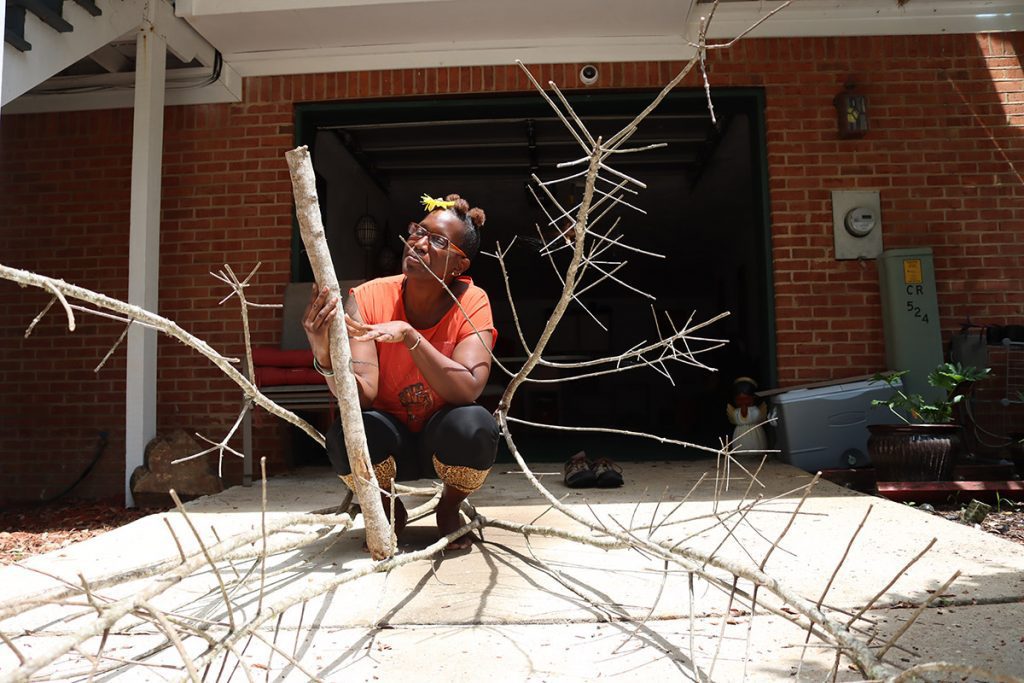The first time I meet Chris Omni, we take off our shoes and walk barefoot in Governor’s Park. It’s an exercise in mindfulness in nature. Without shoes, we walk more slowly and take in our surroundings. We feel the grass in our toes; in the shade the grass is moist, while in full sun it has dried. She notes the shapes and spacing of a row of pines cutting across a large field.
Chris is pursuing a Ph.D. in Art Education at Florida State University. She takes in the textures, the light, and the shadows of the plants we see. It’s a contrast to what has become my approach to nature- to identify plants and animals by name and pay attention to the ecological relationships between them. I’m very much interested in function. Chris Omni is very much interested in form and feel and admits she doesn’t know the names of many of the plants she enjoys.
That enjoyment, the joy, that’s the thing.
Her dissertation is titled Black Joy in Green Spaces. The central research question is What can we Black women learn from being (together) in green spaces? Her previous degrees and work experience are in health care, and her interest is in the healing and restorative properties of time spent surrounded by trees.
She starts officially in the fall but has been busy conceiving the many pieces of her dissertation. One is a business, the Mother Earth Academy. Another is a series of interviews with Black women about their relationship with nature. And yet another is an art installation at LeMoyne Arts in Tallahassee.
Throughout the month of May (2022), I visit Chris as she crafted this, her first exhibited artwork.
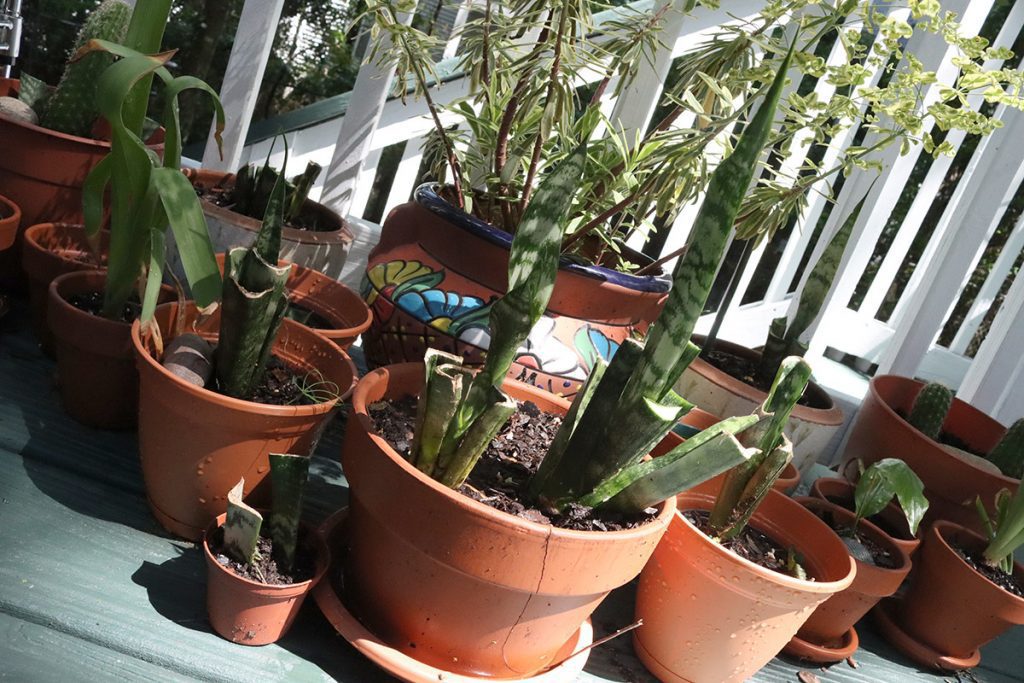
Chris Omni’s Healing Gardens
On a deck, shaded by trees, Chris introduces me to her healing gardens. Each has its own corner of the deck, and each has its own significance.
“So I have a lot of different gardens and a lot of different healing spaces because even though people call me a gardener, I call myself a grower,” Chris says. “A lot of times with gardeners, they say you have a green thumb. And I don’t. You’ll see pretty soon that I have a lot of plants; but as a grower, rather than a gardener, I grow with love.
“No green thumb. I have a green heart.”
The first space is for cast-offs, plants Chris has found abandoned by the side of the road.
“Somebody discarded every last one of these plants,” Chris says. “It was something that they discarded and something that they no longer saw value in. But to me, I saw life and potential.”
Next is a garden of plants gifted to Chris. “When we move to this side, we go from the gift of love that I find, versus the gift of love that is given to me.”
This includes a snake plant which she will, in turn, share with others through her Propagating Joy exhibit. We’ll get to that in a second. First, we’ll visit the third of her healing gardens.
Family Garden
“Everything here is representative of either my granny, my auntie, or my dad,” Chris says. “Granny is 96 years old and she was the original gardener- gardener, grower, lover of all things life and green. And the fact that she’s been around for 96 years- she knows a lot.”
Chris inherited her love of gardening from her family, even if hers is a different kind of garden.
“We all have our own way of expressing our joy through gardening, and mine is through rescues. My dad has vegetables, and granny grows flowers.”
There are no tomatoes or squash on her deck, nor wildflowers swarmed by bees and butterflies. It’s a place for nameless plants to create a space of love and healing. As she works, she talks of losing her mother five years ago. Always finding metaphors in her work, she takes cuttings from the mother snake plant and says, “propagation only works when you take care of the parent plants”
Finding Healing in a City of Trees
Plants have taken care of Chris Omni since she arrived in Tallahassee.
“When I first moved here from Kansas in June of 2020, it was COVID,” Chris remembers. “I didn’t know anybody. I’m a hugger, and so I wanted to connect. So my first form of connection was with a tree. And I have not lost that connection.”
Chris walked her dogs in a new city where she didn’t know anyone, at a time when it wasn’t easy to connect with new people. Immediately, she noticed the difference from the open grasslands she had left behind in Kansas. As we’ve learned previously, Tallahassee is one of the most tree-covered cities in the US.
With an artist’s eye, she gazed upon bark and leaves and branches. Now, on her deck, she motions to one of the trees shading us. “I call it like an eco-love affair, that I will look at this beauty right here and see the bark, see the brown, see the wrinkles and be like, ‘This is me, this is our ancestors. This is growth, this is pain, this is joy.'”
The pain: when Chris walks in the shade of trees, she acknowledges the legacy of lynchings in the south. She also acknowledges the growth and the joy of trees themselves, apart from their unwilling participation in the hateful acts of the past.
Those mixed emotions, and her desire to resolve them, fuel her drive to create art based in nature.
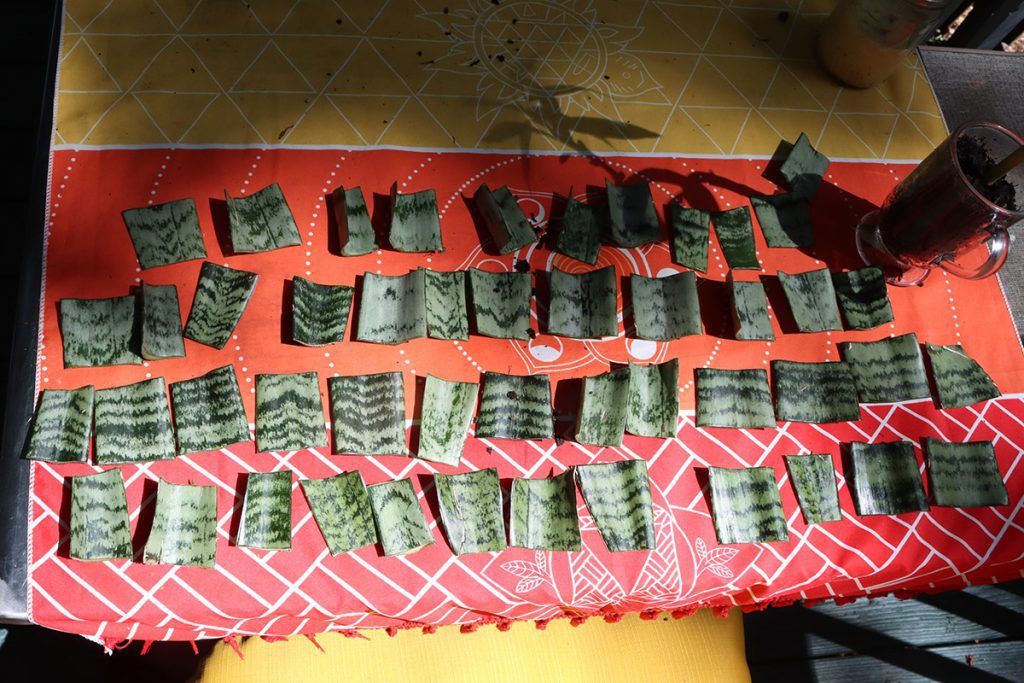
Propagating Joy: the Process
Chris does have a potential project in the works to directly address her feelings on trees and lynchings. If it happens, we’re likely to follow her process on that as well.
Right now, though, Chris has been asked to provide an installation for LeMoyne Arts’ Nature’s Gems exhibit.
She starts with two plants, each representing an aspect of her gardening passion. One is that snake plant, gifted to her by a colleague at Florida State University. Another is a castoff- a large branch that was about to be hauled away from the roadside yard waste pile.
She encountered the branch walking her dogs. “I was attracted to this branch when I was walking the neighborhood, and it was full of dead leaves and dying leaves. So there was green, and there was brown. And what caught my attention was all of these wishbone shapes… so to me, this became like a wishing branch that somebody discarded.”
Above is the branch on her first day of work on it. She saw potential, but the branch needed shaping. She pruned twigs, looking for a visual balance. As I kept returning to film her work, her vision for the final shape of the branch became simpler and simpler. By the end, she had pruned off all of the twigs, leaving the branch in its most simplified shape.
False Starts and Changes in Direction
On my second visit, Chris started to coat the branch in gold spray paint. Gold, for Manipura, the solar plexus chakra.
“The naked bark was beautiful by itself, but I thought it wasn’t going to be enough. I just thought, you know, to me, nature is beautiful. But in the museum, as a part of the Nature’s Gems, I didn’t think it was enough.”
Nature’s Gems features jewelry inspired by nature. Chris figured that a gold finish would match this theme. However, meeting with LeMoyne halfway through the process, she found that they thought differently. Her piece would work better as a contrast to the jewelry, she was told.
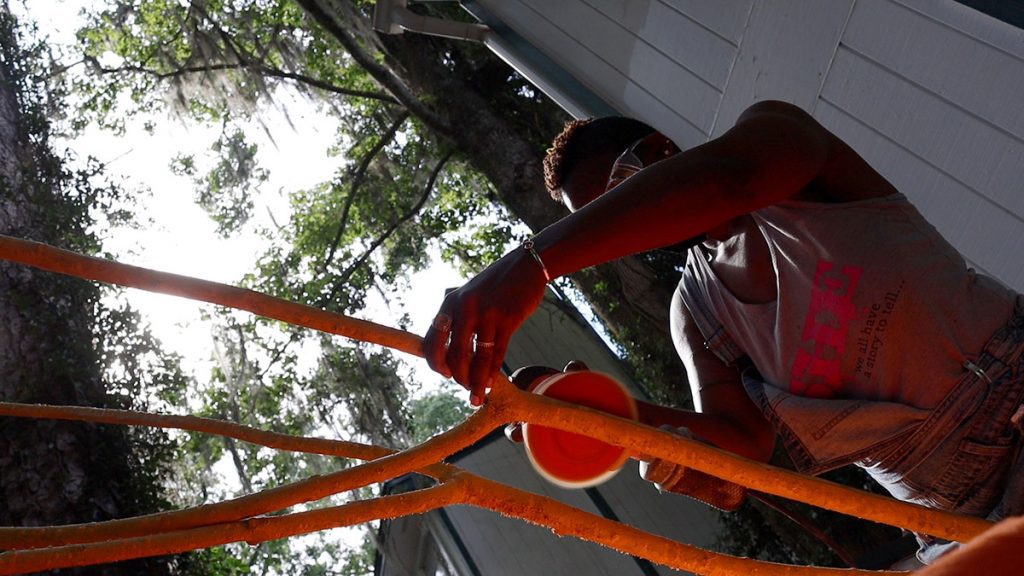
Out came the sander. It stripped off more than just the paint, revealing the smooth wood beneath the bark. Chris was pleased with this new texture, and once again found a metaphor in it.
“To go through those three different stages- the original, the covered, the revealed. I’m revealing myself as the artist.”
Sharing Love Through Plants
The branch is the framework for Propagating Joy. From it, several cuttings would hang, each to be sold and grown as new plants.
The cuttings came from the snake plant I mentioned earlier. She doesn’t know the names of all her plants, but she knows two for this one. She found the name mother-in-law’s tongue disrespectful, so she read up on it and found the name snake plant (Dracaena trifasciata). One thing she learned about the plant is that it can be cut into pieces, and each piece can become a new plant. All one has to do is place the bottom edge of a cutting in water, and new roots start to grow.
On day one, she sliced parent plants into roughly equal-sized strips and skewered them. It’s important that they aren’t fully submerged, but that their feet get wet.
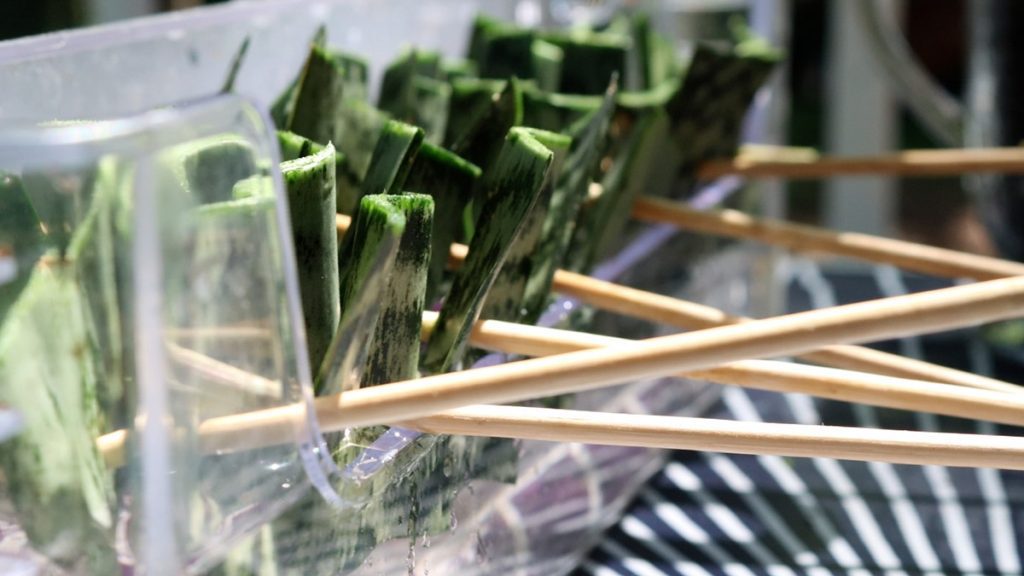
Throughout the weeks, Chris worked on the branch as these sat in water. A couple of days before she took the installation to LeMoyne, she transferred them to small terra cotta pots. She also crocheted slings from which to hang the pots. This was the tensest moment of the process.
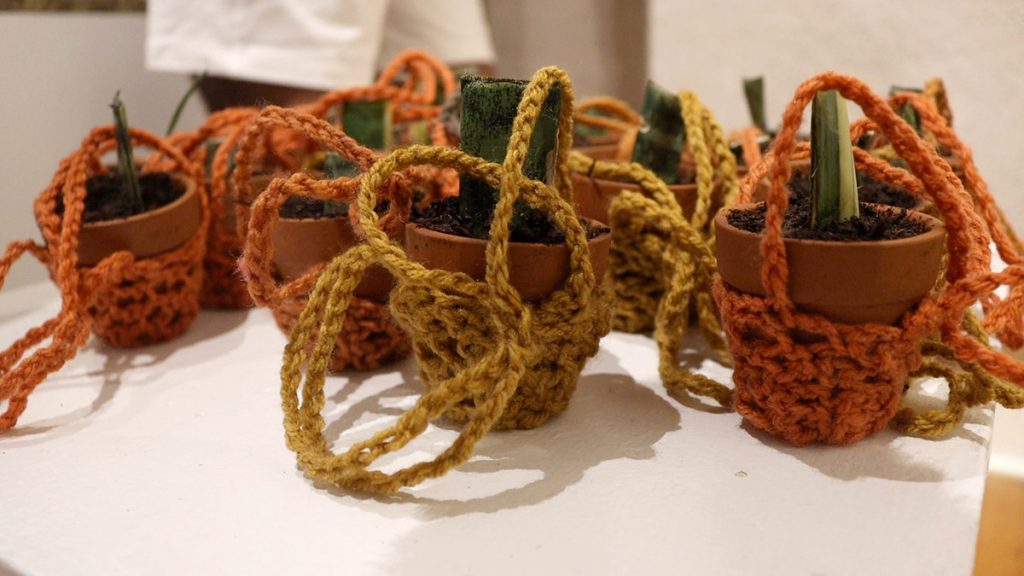
The Moment of Truth
A couple days before Nature’s Gems is set to open, Chris takes all of the components to LeMoyne to assemble. The crocheted slings will hang from hooks in the branch- but the hooks have to be installed. She and the LeMoyne staff consider drilling- but what if the branch cracks?
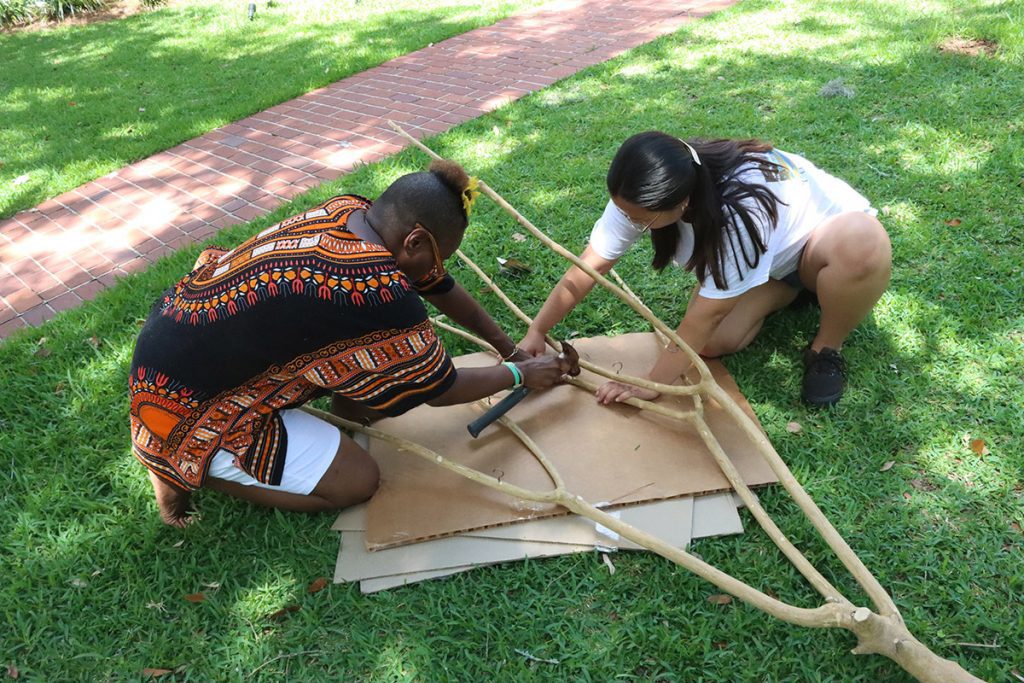
They settle on gently hammering a nail into the wood to create starter holes for the screw-in hooks. Out on the lawn, they figure out how to keep the branch stable, and Chris starts to hammer. We all watch that first screw twist in, past the starter hole.
No cracks. On to the next one.
Tension turns to elation as the pots take their place on the branch. Chris sees the branch under the lights, and is pleased with the shadows on the wall. After a month of pruning and sanding, of dead ends and starting over, we gaze upon Propagating Joy.
“The ancestors have opened these doors and I proudly walk in them,” Chris says. “And I have this conversation about joy and especially Black joy in green spaces, that we do operate in these spaces.
And this is just a piece of me and this is just the beginning.”
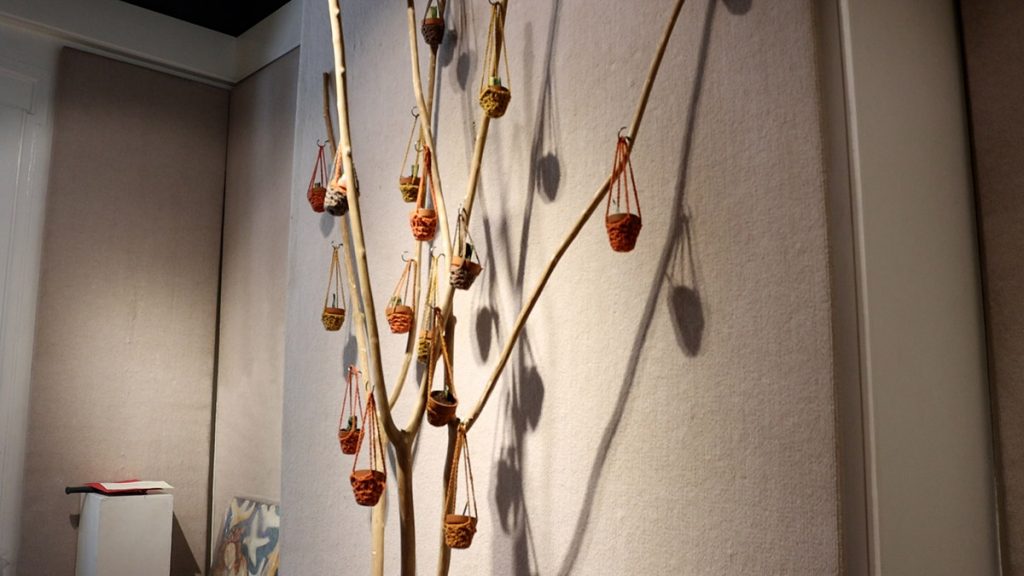
Black Joy in Green Spaces
The backbone of the WFSU Ecology Blog is following scientific research in our natural spaces. Chris Omni’s research project is on green spaces, and yet it is nothing like the other research we cover.
As an auto-ethnographic study, Chris will draw on words shared with her by her research subjects.
“I will invite two other Black women, I call them my Sister Queens, to come and be a part of this research study. And I would ask seven questions that are the theories of Black joy. So the theories of Black joy are poetic.
“Remember this is an arts-based research. So when you ask the question, what is Black joy? The response is poetic:
What is Black joy?
Black joy is a statement.
Black joy is a stride.
Black joy is permission.
Black joy is pride.
Black joy is a form of resistance.
And Black joy is a form of rest.
Black joy is anything and everything you need it to be.
Because truly Black joy is the best.
Chris Omni
I’m looking forward to seeing how the study unfolds, and to share Chris Omni’s findings with you.

